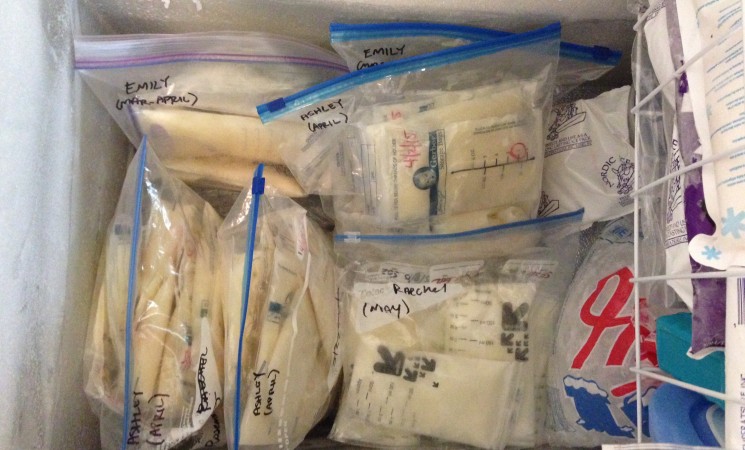Archived Content
This page is archived and provided for historical reference. The content is no longer being updated, and some of the information may have changed over time and could be outdated or inaccurate.

By Aunchalee Palmquist, PhD, IBCLC
In a 2013 NPR interview, Kim Updegrove, president of the Human Milk Banking Association of North America, says:
“The practice of internet sharing of human milk is not safe. Sharing a body fluid with all of its potential bacteria and viruses is dangerous, and it is playing Russian roulette with your child's life.”
This statement reflects the serious public health concerns regarding online social networks designed to facilitate peer-to-peer human milk sharing like Human Milk 4 Human Babies and Eats on Feets. Such concerns resonate with cautionary statements regarding the risks of sharing unscreened human milk that have been released by the U.S. Food and Drug Administration, the Centers for Disease Control and Prevention (CDC), the American Academy of Pediatrics, and the Human Milk Banking Association of North America (HMBANA). Given the considerable risks, why are so many parents doing it?
In an effort to establish a policy-relevant evidence-base for human milk sharing practices in the United States, we analyzed data from a cross-sectional survey on milk sharing experiences. The results of our study, “Human Milk Sharing Practices in the U.S.,” were published in Maternal and Child Nutrition, and describe several dimensions of milk sharing practices, including: the composition of milk sharing social networks, milk sharing practices, milk sharing risk perception, and risk mitigation strategies. We tested the association between perceptions of milk sharing risks and risk mitigation practices to better understand the relationship between risk perception and social behavior. We assessed infant conditions in the respondents’ most recent lactation to ascertain whether or not shared milk was being given to a population that was commonly prioritized to receive banked donor human milk. Finally, we assessed claims that peer-to-peer milk sharing was distinct from peer-to-peer milk selling, despite these two terms being repeatedly conflated in the media and scholarly reports.
Is peer-to-peer milk SHARING distinct from peer-to-peer milk SELLING?
Of 867 respondents (661 donors, 206 recipients), there were no reports of anonymous milk sharing. We defined anonymous milk sharing as giving or receiving milk to someone other than a family member or friend without meeting them in person or asking them screening questions as part of the decision to either accept or give milk. Both donors and recipients engaged a variety of social networks, both online and offline, in their milk sharing practices. Recipients reported utilizing a wider range of social networks to find milk than donors, who tended to rely most heavily on online networks to find recipients. Twenty-nine percent of respondents reported sharing only with a family member or friend.
We assessed risk mitigation practices among recipients, which entailed asking donors various questions about different milk sharing risks. Respondents reported gathering information about prospective donors, but the types of information gathered were variable and linked with social proximity as well as risk perception. In other words, more intensive screening occurred when sharing with strangers than with a family member or friend. Similarly, recipients were more likely to ask screening questions for specific risk factors they were the most concerned about.
Many have attributed the growth of online milk sharing social networks to the fact that, currently, HMBANA milk banks must prioritize their milk to medically fragile babies. Indeed, parents in our study were seeking milk for healthy, full-term babies. Eighty-three percent of recipient infants were born >37 weeks gestation and healthy. The average age of recipient infants was 7 months old. Around 10 percent of both donors and recipients reported also giving or receiving milk through a milk bank.
Peer-to-peer milk sharing has been described as a gift economy, in which milk flows freely from donors to recipients, unfettered by biomedical institutions or commerce. While peer-to-peer milk sharing and peer-to-peer milk sales are not mutually exclusive, only 2 percent of donors and 9 percent of recipients reported buying or selling human milk. Although there is some evidence for the risks of anonymously purchasing milk online, further research is needed to ascertain the risks of peer-to-peer milk sharing using study designs that more closely approximate actual milk sharing practices.
Peer2Peer milk sharing is described as gift economy: milk flows from donors 2 recipients, unfettered by institutions or commerce
Despite the health warnings, online milk sharing communities continue to expand. One explanation is that risk perception and risk mitigation are nested within social relationships, and so they are continuously negotiated within highly idiosyncratic relational contexts. People who are milk sharing may not perceive that public health recommendations cautioning against milk sharing apply to them, because they are employing risk mitigation practices that make sense in the context of their personal relationships. Most of the health messaging about peer-to-peer milk sharing has been negative and highly stigmatizing. The continued growth of milk sharing indicates that these types of public health communication strategies have been ineffective among the parents who are milk sharing.
An evidence-based understanding of milk sharing practices and perceptions of milk sharing risks are essential to developing public health interventions that better support parents and primary infant to caregivers make informed infant feeding decisions.
About the Author

Aunchalee Palmquist, Ph.D. is Assistant Professor of Sociology and Anthropology and Director of the Program for Ethnographic Research and Community Studies (PERCS) at Elon University. She is a medical anthropologist and International Board Certified Lactation Consultant (IBCLC). Dr. Palmquist received her Ph.D. in anthropology (2006) at the University of Hawaii-Manoa. She completed a postdoctoral fellowship (2007-2009) in the Social Network Methods Section of the Social and Behavioral Research Branch, National Human Genome Research Institute, National Institutes of Health, under the mentorship of Dr. Laura Koehly. She completed a second postdoctoral fellowship in global health (2009-2011) at the Jackson Institute for Global Affairs, Yale University. Her recent research focuses on the critical biocultural contexts of breastfeeding and lactation, human milk sharing, and infant and young child feeding in emergencies. Dr. Palmquist’s study of human milk sharing is funded by the Wenner-Gren Foundation and Elon University. She blogs at Anthrolactology.








